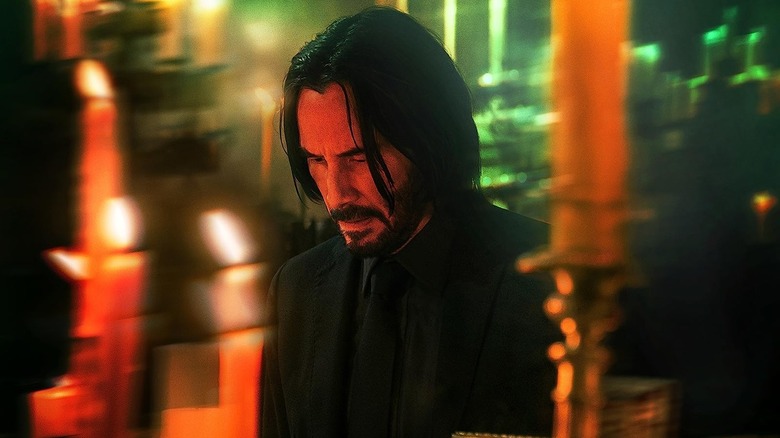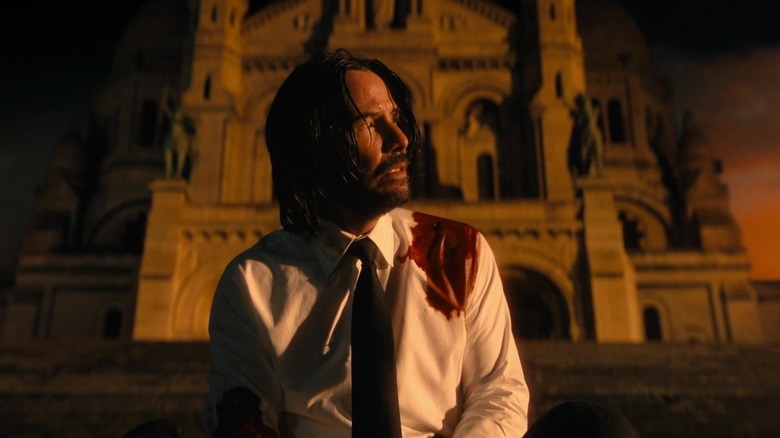John Wick 4's Ending Was Inspired By A Classic Anime
Spoilers ahead for "John Wick: Chapter 4."
The "John Wick" films have always thrived on combining elements from wildly different works of cinema, be they classic noir films, Spaghetti Westerns, '80s shoot-em-ups, or even silent-era slapstick comedies. Just think of the sequence in "John Wick: Chapter 4" where John (Keanu Reeves) battles his way through an endless series of assassins up the Rue Foyatier only to be sent tumbling down all the way to the bottom of the stairs, and tell me it doesn't feel like a stunt straight out of a (really violent) Buster Keaton flick.
Out of the many influences on "Chapter 4," it's Japanese cinema that's perhaps the most obvious — from its casting of Japanese actor Hiroyuki Sanada and Japanese-British singer-songwriter Rina Sawayama as John's old ally Koji and his daughter Akira to the themes of honor and sacrifices it shares in common with countless Samurai films and anime series. Anime, in general, informs many a moment in the film, though perhaps none more so than the climactic scene in which John, having finally secured his freedom from the High Table, seemingly dies from the gunshot wounds inflicted upon him during his duel with his frenemy Caine (Donnie Yen), acting as a stand-in for the Marquis (a sumptuously snively Bill Skarsgård).
Speaking to Comic Book Movie, director Chad Stahelski confirmed what many "Cowboy Bebop" fans no doubt already suspected: that the image of John collapsing on the staircase in front of the Sacré-Cœur at sunrise was modeled after Spike Spiegel's similar demise in Hajime Yatate's classic anime. Stahelski explained:
"I have this favorite anime 'Cowboy Bebop,' where Spike Spiegel dies on the stairs, and Hajime Yatate is a huge influence for me, the director of 'Cowboy Bebop' and the creator. So, that all kind of came together when I saw the location."
Adiós, Mr. Wick?
"Cowboy Bebop" itself draws inspiration from a myriad of Western pop culture sources (noir, classic Westerns, Blaxploitation), as well as everything from the French New Wave to the "bullet ballets" of John Woo and other international genres and directors. It's a lot like the "John Wick" films in that respect, so much so that the "John Wick" francise is arguably more faithful to the ethos of "Cowboy Bebop" than Netflix's short-lived live-action reimagining of the anime. And lest we forget, Keanu Reeves himself nearly starred in a live-action "Cowboy Bebop" film many years ago, further cementing the intangible yet undeniable connection between the two properties.
Unlike Spike Spiegel, however, John's "death" might not be so permanent, with "John Wick 5" already confirmed to be in the earliest stages of development. Chad Stahelski even admitted there's a shot near the end of "Chapter 4" — where John's dog looks at someone off-screen aside John's gave — that might just allude to John the man being alive, even if the "myth" he embodied is now dead and buried. In Stahelski's words:
"[...] That is a very deliberate shot with the dog. That's meant, in my little mind, to [frick] with you a little bit, because ambiguity, like is he still or not? Because again, the whole thing is a myth. It's a campfire story, all four movies. So, in my mind, John Wick, is he real? Is he not real? It's a story about fate and consequence. So, either way, John Wick died at the end of that movie. Now, is John still alive? Maybe, but the persona of the assassin has had to pass away so that John can move forward."
Yeah ... I'm thinking John's coming back, whether he likes it or not.

